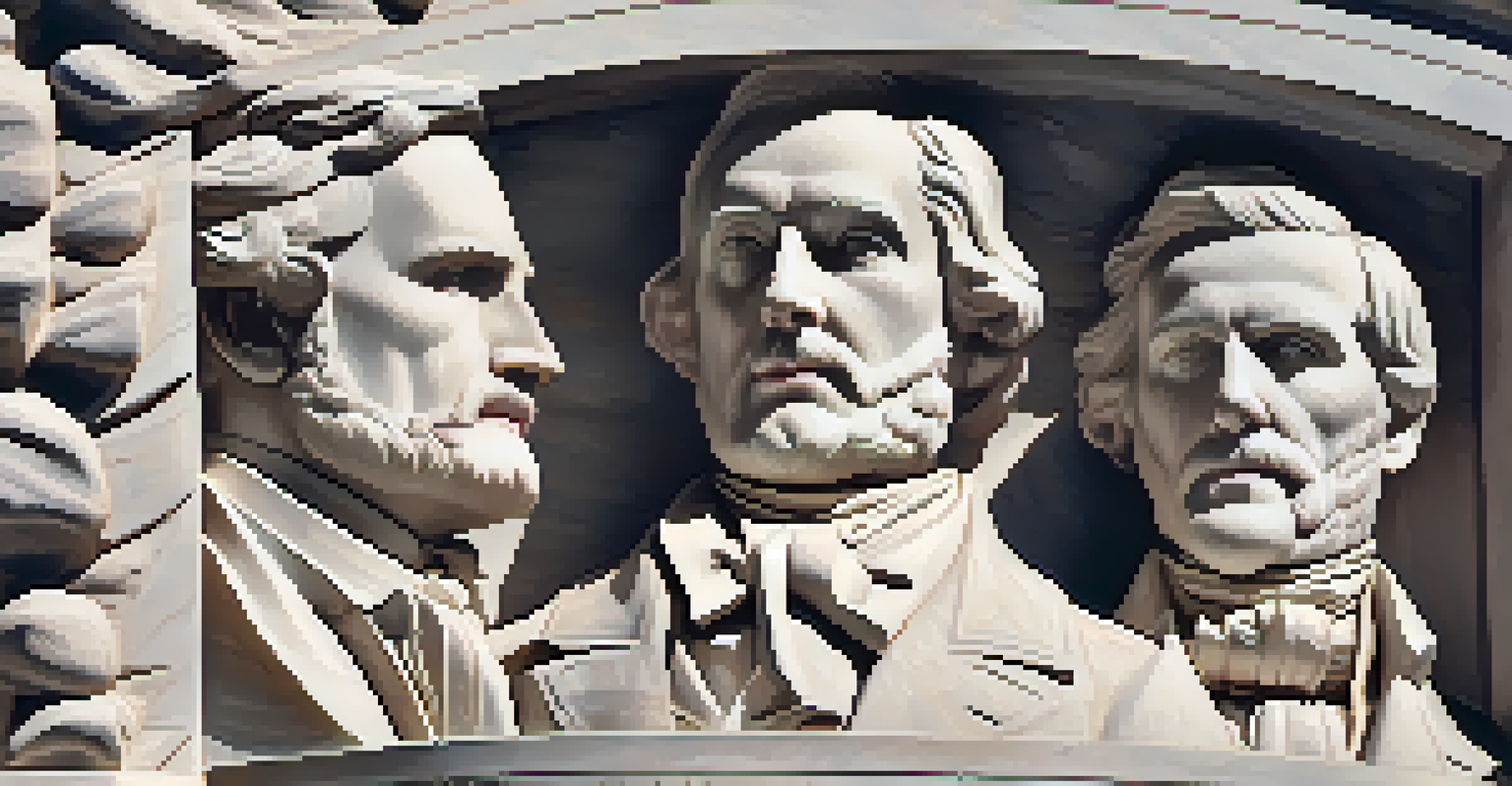Stone Mountain: A Monument of Southern History

Introduction to Stone Mountain: A Southern Icon
Stone Mountain, located just outside Atlanta, Georgia, is more than just a geological wonder; it’s a symbol steeped in Southern history. Towering at 1,686 feet, this granite monolith is the largest exposed piece of granite in the world. Its historical significance is deeply intertwined with the cultural and political narratives of the South, making it a focal point for both tourists and historians alike.
History is not a burden on the memory but an illumination of the soul.
Visitors flock to Stone Mountain not just for its stunning views but also for the array of activities that the park offers, from hiking to laser shows. These attractions, however, often overshadow the deeper, more complex stories that the mountain tells about the region's past. As we peel back the layers of this iconic landmark, we discover a narrative that reflects the tumultuous history of the South.
Understanding Stone Mountain requires a look at its origins, not only as a natural landmark but also as a site of historical significance. From the Civil War era to the civil rights movement, Stone Mountain has witnessed pivotal moments that have shaped Southern identity and culture.
The Carving: Controversial Artistry on the Mountain
One of the most striking features of Stone Mountain is the massive carving on its northern face, depicting three Confederate leaders: Jefferson Davis, Robert E. Lee, and Stonewall Jackson. Completed in 1972, this carving has become a focal point of controversy, symbolizing the Confederacy and its complex legacy. While some view it as a tribute to Southern heritage, others see it as a painful reminder of a history marked by slavery and division.

The decision to carve the monument was influenced by the resurgence of the Ku Klux Klan in the early 20th century, highlighting the intersection of art, politics, and race in American history. This monument has sparked debates about its appropriateness in today’s society, as many advocate for its removal, arguing it glorifies a troubling past. Yet, preserving the carving as part of historical education is equally argued, emphasizing the need to confront rather than erase history.
Stone Mountain's Historical Significance
Stone Mountain is a complex symbol of Southern history, intertwining narratives from the Civil War to the Civil Rights Movement.
The discussions surrounding the Stone Mountain carving reflect broader conversations about how society remembers and honors its history. By examining these differing perspectives, we can better understand the complexities of Southern identity and the ongoing struggle to reconcile with the past.
Stone Mountain's Role in the Civil War
During the Civil War, Stone Mountain served as a strategic lookout point for Confederate troops. Its elevated position provided a vantage point for monitoring Union movements, making it a critical site for military strategy. The mountain’s natural landscape played a significant role in the war, influencing tactics and decisions made by Southern leaders.
We cannot change the past, but we can learn from it.
Beyond its military significance, Stone Mountain became a symbol of the Confederacy's struggle and resilience. The battles fought nearby and the stories of soldiers who traversed its slopes are woven into the fabric of Southern lore. This historical context adds a layer of complexity to the site's legacy, as it embodies both pride and pain for many.
Today, historians and enthusiasts alike explore Stone Mountain to uncover its Civil War history. Guided tours and educational programs help visitors appreciate the mountain's role in this pivotal era, encouraging discussions about the implications of these events on contemporary society.
The Civil Rights Movement and Stone Mountain
Stone Mountain's significance extends into the Civil Rights Movement, serving as a backdrop for both protests and celebrations. In the 1960s, activists gathered at the mountain to voice their demands for equality and justice, underscoring its dual role as a site of struggle and hope. The mountain witnessed a critical transition in Southern society, as voices for change rose against an oppressive past.
The juxtaposition of the Confederate monument with the civil rights actions reflects the ongoing conflict over Southern identity. For many activists, the mountain represented a painful reminder of the struggles faced by African Americans, prompting calls for a re-evaluation of its symbolism. This complexity is essential to understanding how public spaces can evoke both pride and pain.
Controversial Carving and Identity
The massive Confederate carving on Stone Mountain ignites debate over Southern heritage and the legacy of division and slavery.
Today, Stone Mountain is a location for continued dialogue about race relations and history in America. Through educational initiatives and community events, the park aims to foster understanding and promote healing, acknowledging the mountain's multifaceted legacy in the ongoing pursuit of equality.
Recreation and Family Fun at Stone Mountain Park
Beyond its historical significance, Stone Mountain Park is a popular destination for families and outdoor enthusiasts. With over 3,200 acres of natural beauty, the park offers a multitude of recreational activities, including hiking, biking, and picnicking. The stunning views from the summit are a reward for those who venture to the top, making it a cherished spot for nature lovers.
Families can enjoy a variety of attractions, such as the SkyRide, which provides a scenic aerial view of the mountain and surrounding area. Seasonal events, including the famous Stone Mountain Christmas and the Lasershow Spectacular, draw crowds each year, blending entertainment with the park's rich history. These experiences create lasting memories, encouraging visitors to connect with nature and history simultaneously.
The park's ability to cater to both adventure seekers and history buffs makes it a unique destination in the South. By offering engaging activities that celebrate the mountain's legacy, Stone Mountain Park invites visitors from all walks of life to explore and reflect on its significance.
Preservation Efforts: Balancing History and Progress
As discussions about the monument and its implications continue, preservation efforts at Stone Mountain are more important than ever. Balancing the historical significance of the site with the need for progress is a delicate task for park management and the community. Initiatives aimed at educating visitors about the mountain's complex history are essential in fostering a more inclusive understanding.
Collaborations with historians, community leaders, and activists are paving the way for programs that honor all aspects of the mountain's legacy. These efforts include guided tours that highlight diverse narratives, allowing for a more comprehensive portrayal of Stone Mountain’s history. By acknowledging the past while promoting dialogue, the park can become a space for healing and understanding.
Recreation Amidst Reflection
Stone Mountain Park offers recreational activities while encouraging visitors to engage with its rich and multifaceted history.
Ultimately, the future of Stone Mountain lies in its ability to adapt and grow. As society evolves and conversations about race and history continue, the park remains committed to fostering an environment where visitors can engage with its rich, yet complicated, heritage.
Conclusion: Stone Mountain's Legacy and Future
Stone Mountain stands as a testament to the South's intricate history, embodying both the beauty of nature and the weight of its past. As we explore its significance through various lenses—be it the Civil War, the Civil Rights Movement, or contemporary recreational use—we begin to appreciate the multifaceted legacy of this iconic site. Understanding Stone Mountain is not merely about recognizing its physical presence but also about grappling with the stories it holds.
The ongoing discussions surrounding the mountain highlight the importance of engaging with history in a thoughtful manner. By acknowledging all aspects of its legacy, we can foster a deeper understanding of how the past informs our present and future. Stone Mountain is not just a monument; it’s a living narrative that continues to evolve.

As we look ahead, Stone Mountain has the potential to be a beacon of dialogue and education, where history informs progress. By embracing its complexities, we can ensure that the mountain remains a relevant and engaging part of Southern history for generations to come.